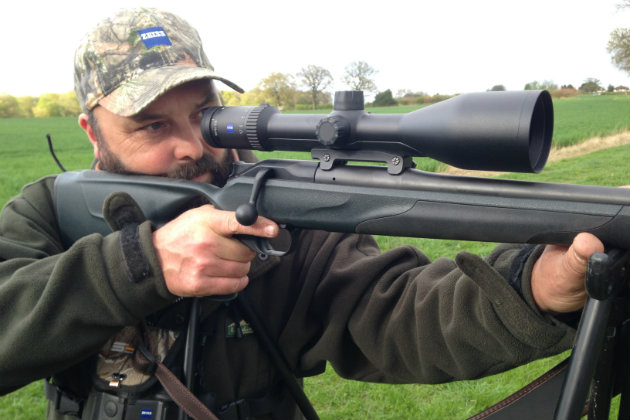The new ZEISS Conquest V6 scope on test
Sporting Gun editor Matt Clark takes the new scope out into the field to see what's on offer

Zeiss Conquest V6 scope
Low light conditions sort out the men from the boys when it comes to optics. Budget scopes – while offering reasonable image quality in good light conditions – often become useless when the light starts to fade. The mid-range new ZEISS Conquest V6 2 – 12 x 50 scope boasts an impressive 92 per cent light transmission, so I took it for an evening stalk to see how it faired in low light conditions.
The range
Naturally, before I ventured into the field with a new scope and rifle, I needed some range time. I went to the ZEISS Centre of Excellence, DGVM Ltd, in Cambridgeshire and the Conquest was mounted on a new Blaser R8 rifle. I always think it’s important to match the scope and rifle in terms of quality, so you get the optimum performance out of both.

The scope’s turrets are well-engineered, working smoothly and precisely
At 100 metres the targets with the naked eye seemed like tiny dots, but once I got settled behind the butt of the rifle and twisted the power ring to get a closer look, the clarity made the targets pin sharp. The black and white rings of the target were crisply in focus and the fine crosshairs of the reticle didn’t obscure the target.
I shot a few rounds and I could clearly see my shot placement without the need for a spotting scope. The rifle was shooting low, so I adjusted the elevation by a couple of clicks and that brought the point of impact up.

Matt Clark was impressed when he tested out the ZEISS Conquest V6 on the range
So far so good, but that was testing the new Conquest on the range in good light conditions, the next test would be stalking in woodland as dusk was falling, courtesy of Chiderley Sporting.

The scope boasts an impressive 92% light transmission
Talking the stalk
We arrived at the estate in Hertfordshire late in the afternoon. The sun was just emerging having been covered with cloud earlier in the day and it was turning out to be a beautiful evening.
After a safety briefing I went out with my guide, Jim Riley, to stalk muntjac. Walking down a farm track we almost blundered into one as it crossed the track before leaping off into the undergrowth. We came to a large drilled crop field and scanned the horizon with our binos. Two fallow deer, way out of range, looked nonchalantly over their shoulders at us before disappearing over the horizon.
Jim suggested venturing into the woodland and we came to a ride where there were lots of fresh muntjac tracks in the soft mud. This was a deer hotspot. Positioning ourselves further down the ride and with the sun behind us, we waited in ambush.
The sun was setting and the temperature began to drop. But still we waited. I watched as grey squirrels frolicked on the woodland floor. Jim, knowing what I was thinking said, “The .308 is too much gun for that!”
Then, we heard a rustle from the undergrowth. I glassed the area with the binoculars and we saw a muntjack buck. Sadly, bucks were off the menu that evening. Our fieldcraft must have been good because we saw another buck 10 minutes later no more than 50 metres away.
Low light
By now the light was fading fast, so we decided to call it a day. As we walked back to the vehicle I wanted to test the light gathering ability of the scope. At the margin of the trees I could just make out a dark blue feeder with my naked eye. According to Jim’s ZEISS rangefinder binoculars it was 104 metres away. I looked through the Conquest to see what sight picture I got and I was impressed. The plastic feeder was clearly visible. I zoomed out on the scope to allow better light gathering and the sight picture was even better. The objective bell and the FL glass (previously only found on ZEISS’ Victory scopes) certainly gave optimal light gathering.
I adjusted the illuminated reticle’s brightness. With some scopes the brightest setting can burn out your retina, especially when you use them in low light conditions, but with the Conquest, the range of illumination range was perfect.
Another point to mention here is that the reticle was activated and deactivated thanks to an intelligent motion sensor. Turn the rifle on its side or point it up or down and the illuminated reticle switches off, which means there is never a risk of the batteries running flat because you forgot to switch off the reticle. Not that I ever forget to switch things off of course!
What I thought of the ZEISS Conquest V6 scope
The Conquest V6 is an excellent all-round hunting scope. The fine crosshairs ensures maximum target visibility, the illuminated reticle switches off automatically, the light gathering is superb and the turrets are easy to adjust. Are there any drawbacks? You might say that at £1,384.99 price tag is one, but in the scope market you usually get what you pay for. And this scope is made in Germany, so the quality will remain long after the price tag has been forgotten.
Specification
ZEISS Conquest V6 (2 – 12×50)
Magnification: 2-12x
Field of View at 100m: 20.5–3.4m
Image Plane: 2
Tube Diameter: 30 mm
Colour: Black matt
Price (inc. VAT): £1,384.99
Surcharge ASV (inc VAT): £155
For more information visit Zeiss
Options
There are three scopes in the new ZEISS Conquest range, the V6 1.1 – 6 x 24, which gives a large field of view, the compact V6 2 – 12 x 50 tested here and the V6 2.5 – 15 x 56.








